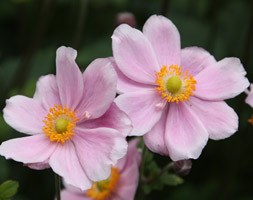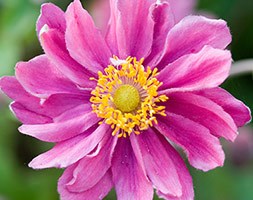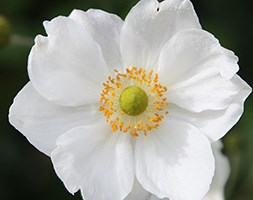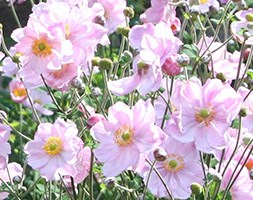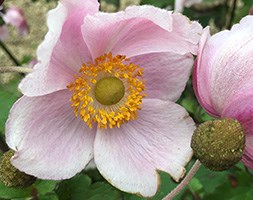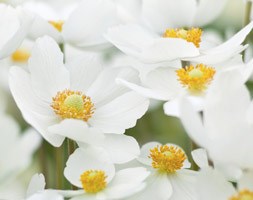Price reductions at Crocus
by Sarah - June 15th, 2014.Filed under: Crocus, Price Reductions.
Reduced items at Crocus
Anemone x hybrida ‘Montrose’ (Japanese Anemone) was £6.99 now £4.99
Position: full sun or partial shade Soil: moist, fertile, humus-rich soil Rate of growth: fast-growing Flowering period: August to October Hardiness: fully hardy Larger than average soft pink blooms, each with up to 40 quilled petals, top wiry upright stems from late summer to mid-autumn. The foliage is interesting too, as it has a distictly ruffled appearance. A reliable and floriferous form that is useful for adding late colour to the border. Garden care: Cut back the stalks after the flowers have faded, and tidy up old dead leaves in March. Apply a generous 5-7cm (2-3in) mulch of well-rotted garden compost or manure around the base of the plant in spring. Avoid moving the plant since it resents disturbance. Where necessary, lift and divide congested clumps in early spring.
Anemone hupehensis var. japonica ‘Pamina’ (Japanese anemone) was £5.99 now £4.99
Position: fu ll sun or partial shade Soil: moist, fertile, humus-rich soil Rate of growth: fast-growing Flowering period: July and August Hardiness: fully hardyGreat for adding a splash of colour to the garden in mid to late summer, this anemone produces la rge, double, deep pink, cup-shaped flowers throughout July and August above clum ps of pretty, deeply cut, deep green leaves. These award-winning Japanese anemon es are perfect for the middle of a partially shady border, though they will grow in sun, too. More compact and lower growing than other varieties, they’re particularly suitable for small gardens.Garden care: Cut b ack the stalks after the flowers have faded. Tidy up old dead leaves in March, t hen mulch well. Avoid moving the plant since it resents disturbance. Wher e necessary lift and divide congested colonies in early spring.
Anemone x hybrida ‘Honorine Jobert’ (Japanese anemone) was £8.99 now £6.99
Position: full sun or partial shade Soil: moist, fertile, humus-rich soil Rate of growth: fast-growing Flowering period: August to October Hardiness: fully hardy A fabulous plant for brightening up the garden in late summer, this anemone grows in sun or shade and has masses of elegant, cup-shaped, white flowers on tall, wiry stems from August to October. The leaves are vine-like, dark green, and semi-evergreen. These single flowered Japanese anemones are one of the plants traditionally associated with Japanese gardens, where they’re grown against dark rocks or in the shade of trees. Best in partial shade, they are perfect for lighting up a dark corner of the garden, or at the back of a herbaceous border. Garden care: Cut back the stalks after the flowers have faded, and tidy up old dead leaves in March. Apply a generous 5-7cm (2-3in) mulch of well-rotted garden compost or manure around the base of the plant in spring. Avoid moving the plant since it resents disturbance. Where necessary, lift and divide congested clumps in early spring.
Anemone x hybrida ‘Konigin Charlotte’ (Japanese anemone ( syn. Queen Charlotte )) was £8.99 now £6.99
Position: full sun or partial shade Soil: moist, fertile, humus-rich soil Rate of growth: fast-growing Flowering period: August to October Hardiness: fully hardy A fabulous plant for bringing colour to the garden in late summer and autumn, this anemone has masses of large, pink, cup shaped flowers on tall, wiry stems from August to October. The leaves are pretty, too – vine-like, dark green, and semi-evergreen. These award-winning, semi-double, Japanese anemones are perfect for areas of partial shade towards the back of a moist herbaceous or mixed border. One of our recommended plants, if left undisturbed they will soon spread to form majestic clumps. Garden care: Cut back the stalks after the flowers have faded. Tidy up old dead leaves in March. Apply a generous 5-7cm (2-3in) mulch of well-rotted garden compost or manure around the base of the plant in spring. Avoid moving the plant since it resents disturbance. Where necessary lift and divide congested clumps in early spring.
Anemone x hybrida ‘September Charm’ (Japanese anemone) was £7.99 now £6.99
Position: full sun or partial shade Soil: moist, fertile, humus-rich soil Rate of growth: average Flowering period: July to September Hardiness: fully hardy A fabulous plant for bringing colour to the garden in late summer and autumn, this anemone has masses of large, rosy pink, cup-shaped flowers on tall, wiry stems from July to September. One of the most reliable and free-flowering of the Japanese anemones, these have distinctive purple-tinted stems and outer petals, which contrast beautifully with the pale pink inner petals. The leaves are pretty, too vine-like, dark green, and semi-evergreen. They are perfect for areas of partial shade towards the back of a moist herbaceous or mixed border. Garden care: Cut back the stalks after the flowers have faded. Tidy up old dead leaves in March. Apply a generous 5-7cm mulch of well-rotted garden compost or manure around the base of the plant in spring. Avoid moving the plant since it resents disturbance. Where necessary lift and divide congested clumps in early spring.
Anemone sylvestris (snowdrop anemony, snowdrop windflower) was £7.99 now £6.99
Position: full sun or partial shade Soil: moist but well drained, humus-rich soil. Likes neutral or alkaline soils Rate of growth: fast Flowering period: April – May Hardiness: fully hardy A lovely little anemone which forms a mound of deeply cut foliage, topped with nodding white flowers with yellow centres in late spring. The plant gets its common name from the way the flower buds emerge on bent stems, so they hang like snowdrops. Then they straighten up and face outwards as the flowers start to open. The petals catch the breeze, making them look a little like butterflies, and they will grow to form open cup shapes up to 7cm across. They are scented and are good for cutting, but if you leave them on, they will be followed by white woolly seedheads. Find the right spot for them and they will naturalise and spread into large clumps. Garden care: Apply a generous 5-7cm mulch of well-rotted garden compost or manure around the base of the plant in spring. Cut back to just above ground level if they start to look messy and they will quickly rejuvenate. Where necessary, lift and divide congested clumps in early spring.







